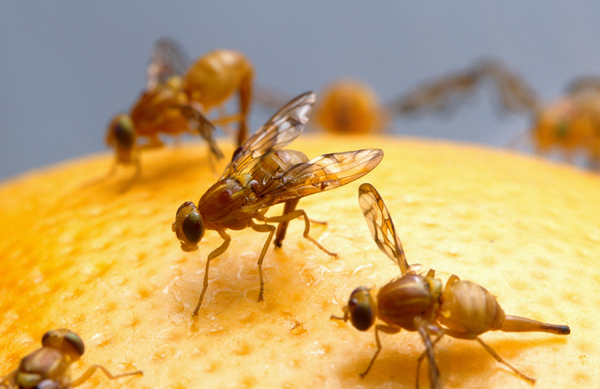- La Feria Native Soon To Retire From The Military This Summer
- Senior Eneece Avila Takes Pride in her State Title
- Dr. Noemi Infante, Harlingen Medical Center Open New Women’s Clinic
- Santa Rosa Cameron County Park Partially Reopens
- Santa Rosa Takes to Regionals Meet in Kingsville, Tx
- Long-Standing Nexstar Tower in La Feria Decommissioned
- Lionettes Powerlifting Meet
- Local Business Holds Event to Benefit RGV Shriners Club
- Knights of Columbus Holds it’s 30th Annual Golf Tournament
- KGBT Tower Dismantled
Mexican Fruit Fly Control Needs Citizen Help to Keep Texas Citrus Industry Vibrant
- Updated: October 20, 2017

The Texas citrus industry needs help from people with backyard citrus trees to combat the Mexican fruit fly. Photo: Kay Ledbetter/Texas A&M AgriLife
by Kathleen Phillips/Texas A&M AgriLife
COLLEGE STATION — The success of the Texas citrus industry may hinge on a lot of variables, but a tiny fly and people with backyard citrus trees are high on the list.
Allowing fruit to linger on a tree provides a paradise for Mexican fruit flies by keeping their reproductive cycle in business, but that can slap a quarantine on citrus in the area and limit markets, according to Dr. Olufemi Alabi, Texas A&M AgriLife Extension Service plant pathologist in Weslaco.
Some 27,000 acres of citrus in a three-county area of the Lower Rio Grande Valley annually yield more than 9 million cartons of fresh grapefruit and oranges plus 5 million cartons of juice fruit valued at more than $100 million, according to Texas Citrus Mutual.
Alabi said an additional 1 million trees are estimated to be growing in yards of individual residences. Those trees, he said, are not managed for the fruit fly.
“Basically if you have Mexican fruit fly detections in a location, fruit from there cannot be sold outside of that area,” said Dr. Mamoudou Sétamou, Texas A&M University-Kingsville Citrus Center entomologist, Weslaco. “It is a very big threat to the industry.”
The Mexican fruit fly is called a “quarantine pest” because it has multiple hosts and is regulated due to its potential to damage fruit, Alabi said. No country wants it to show up and disrupt domestic and international trade.
The adult lays its egg inside the fruits, so it is not easily detected, he explained. And if the egg-infested fruit is moved from the area it was grown, the egg will hatch, emerge and thus begin reproducing in a new area.
It is a very big trade issue and not just for citrus but other fruit such as mango and avocado, the researchers said.
Damage from the insect feeding on the flesh inside destroys the fruit, Alabi said.
“But more importantly, consumers do not want to see a fly inside their fruit or juice, so that itself is a very big problem, which is why it is tightly regulated by many countries,” Sétamou added.
Inspectors regularly survey trees and groves for the Mexican fruit fly during the growing season and inspect fruit during the marketing season, Alabi said, and quarantines can be levied when the pest is detected and lifted if no new detections are found after treatment is applied to eliminate the fly. That is routine for commercial growers.
“Citrus growers know that this is their bread-and-butter, and they know that if Mexican fruit fly is detected, that will trigger a quarantine and the end of the marketing season for them,” Sétamou said. “Because of that, they invest a lot of money into chemical control and the use of bait sprays, in addition to the areawide biocontrol program of using sterile flies.”
The U.S. Department of Agriculture-Animal and Plant Health Inspection Service produces and distributes the sterile flies. The Texas Department of Agriculture also contributes to the area-wide monitoring of the flies by servicing traps and ensuring that quarantines put in place are respected by the stakeholders, according to Alabi and Sétamou.
But none of that applies to residents who have backyard trees, they said.
“For the Mexican fruit fly to complete its lifecycle it needs fruit, so when there is a continuous presence of fruit — especially mature fruit — then basically that helps complete the lifecycle of the Mexican fruit fly,” Sétamou said. “And what we have seen in the citrus areas is that many residents do not harvest their fruit, especially from orange trees.”
Alabi said part of the “excitement” about having citrus trees around a home is the ability to pick the fruit only when wanted rather than all at once as in commercial groves.
“We have a lot of new properties that were formerly citrus groves, and the developers have built some of the properties around citrus trees as a way of attracting new homeowners,” Alabi said. “But a homeowner may have from one to 20 or more trees and not know how to maintain them.
“They don’t know that they have to harvest the fruits by a certain time and that is not only to disrupt the Mexican fruit fly life cycle but to keep the tree bearing for the next season.”
He said the Mexican fruit fly can deposit its eggs in fruits left on a tree, while the tree physically knows there is fruit remaining so it does not bloom the next season.
Another problem is that some trees left untended have reverted to old rootstock, which now yields tasteless fruit of no value, Alabi said. The owner of such a tree may not feel an incentive to pull the fruit from that tree since it cannot be used.
“The Mexican fruit fly does not discriminate between fruit that tastes good or bad to us,” Alabi said. “Therefore, we strongly encourage homeowners to harvest their fruit whether for consumption or not by April 30 of each year. Even fruit lying on the ground needs to be picked up, double bagged and disposed of properly in the trash. That will disrupt the lifecycle of the Mexican fruit fly so that the newly developing fruit in the next season are not going to be infested.
“One of the things that can easily push growers out of the business is the detection of the Mexican fruit fly. Our industry produces for the fresh fruit market, so we have zero tolerance for any pest that will make it hard to sell the fruit at market,” he said. “One of the things that makes the Valley unique is citrus, and I’m sure people want to keep it that way.”
Additional information on how to help control the Mexican fruit fly is available at https://www.youtube.com/watch?v=f-bowEytE1o;https://www.youtube.com/watch?v=ngvWWWxfkyE; or http://www.citrusalert.com/; or by calling South Texas Citrus Alert at 956-580-1917.







